New Vrindaban to Host 2017 ISKCON North America Farm Conference
New Vrindaban to Host 2017 ISKCON North America Farm Conference
By Madhava Smullen for ISKCON New Vrindaban Communications

Sunflowers grown in New Vrindaban gardens
New Vrindaban is set to host the second annual ISKCON North America Farm Conference from October 13th to 15th this year.
The GBC Ministry for Cow Protection and Agriculture, which organized conferences on simple living in four continents last year, is behind the event. The conference, themed “Back to the Basics,” will be facilitated by ECO-Vrindaban and ISKCON New Vrindaban.
Organizers include ISKCON Minister for cow protection and agriculture Kalakantha Das; ECO-Vrindaban board chairperson Sri Tulasi Manjari Dasi; volunteer coordinator Mukunda Das; ISKCON Alachua’s Save the Cow program co-director Kesihanta Das; and Gita-Nagari farm representative Keshi Mardana Das.
Representatives from thirty farming efforts all over the U.S., Canada and Mexico will be invited. The conference will feature presentations, demonstrations and hands-on workshops held onsite at different cow protection and agricultural facilities throughout New Vrindaban. Topics will include cow care, oxen training, planting, cover cropping, disease control, greenhouses, and organic pest control.
The main goal of the conference is to help facilitate a network of support amongst established and aspiring devotee farmers, gardners and cow protectors.
Sunflowers grown in New Vrindaban gardens
“We’re all so spread out, so if we start building relationships, it might just make farming a little bit easier,” says co-organizer Sri Tulasi Manjari. “For instance, one farmer might say, ‘I did this for my cow when it got mastisis,’ and another might share, ‘I use this soap to get rid of aphids.’ It creates a support network where we can just call or email someone who might know the answer to a problem, saving each farmer from having to learn everything from scratch.”
The conference also aims to inspire devotees who are not yet pursuing the simple life to make some effort towards it.
“We hope to raise awareness that farming is an important part of Srila Prabhupada’s instructions,” says Sri Tulasi. “And we’d like to encourage devotees in North America to take up some form of agriculture, whether it be growing flowers for their Deities, starting a local community garden, or working together to protect cows.”
The ‘Back to the Basics’ conference at New Vrindaban is just one of a worldwide series of Ministry for Cow Protection and Agriculture conferences this year, which will include gatherings in Nova Gokula, Brazil, New Vraja Dhama, Hungary, and more.
“ISKCON New Vrindaban and ECO-Vrindaban are pleased to host this conference in hopes to inspire as many devotees as possible to engage in farming,” Sri Tulasi beams.
To see the full list of previous and upcoming ISKCON farm conferences around the world, visit http://farmconferences.iskcon.co/
For regular updates, visit the ECO-Vrindaban Facebook Page: https://www.facebook.com/ECOVrindaban
To find out more, visit the ISKCON GBC Ministry of Agriculture and Cow Protection at https://www.facebook.com/imcpa/?fref=ts
ECO-Vrindaban logo
Introducing Dr. Vignesh Ramanathan
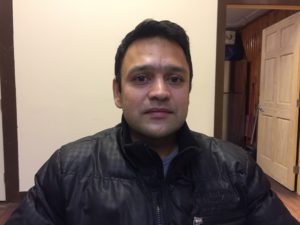
This is to introduce Dr. Vignesh Ramanathan who has very kindly agreed to visit New Vrindaban on a regular basis to take care of the residents’ health care needs. He is board certified in Internal Medicine and currently works at United Hospital Center, Bridgeport, WV where he has been on their Hospitalist staff since 2011.
Dr. Vignesh graduated from Rajah Muthiah Medical College, Chidambaram, Tamilnadu, India with MBBS degree in 2002. He moved to the United States in 2004. He did an internship in Internal Medicine in Washington, D.C. from 2005 to 2006 and subsequently joined Columbia University, New York as a Post-Doc Research Fellow from 2006 to 2008. Following this, he completed a three-year Residency in Internal Medicine from Albert Einstein University-Montefiore Hospital, New York in 2011. He has been in his current position at United Hospital Center since then.
Dr. Vignesh will give us advance notice of at least two weeks before his visits. This will give us ample time to make appointments with him. He will be seeing patients in the Wellness Center. He plans to initially visit on a monthly basis and will provide his email address and mobile phone number to the patients who see him in case they need to contact him.
Please welcome him to New Vrindaban in the traditional Brijbasi spirit of love and devotion.
Department Reports in New Vrindaban Show Continued Progress Towards Prabhupada’s Vision
By Madhava Smullen for ISKCON New Vrindaban Communications
Kicking off ECO-Vrindaban and ISKCON New Vrindaban’s end-of-year Joint Board Meetings, their Department Head Reports on Saturday November 12th were uplifting to members of the community who attended the open event.
Showing steady progress towards Prabhupada’s vision, the reports also revealed that the past half a decade’s concerted efforts at rebuilding New Vrindaban are gradually beginning to move past upgrading existing facilities, and onto new and exciting ventures.
In his introduction, ISKCON New Vrindaban Temple President Jaya Krsna Das laid out a mission to attentively follow Prabhupada’s instructions for the community; to care deeply for visitors, cows, Sri Sri Radha Vrindabanchandra and one another; to cooperate with residents, management and ISKCON’s international leadership; and to one day see every devotee in North America and beyond proud of and honored to be associated with New Vrindaban.
Starting the reports, Brihat Kirtan Das, who became Devotee Kitchen manager in spring 2016, thanked ECO-V’s Nitaicandra Das for familiarizing him with the fresh produce available to use. He added that the kitchen has also been using ghee from protected cows and brown sugar instead of white sugar; and has purchased a commercial oven that can bake much larger batches at once.
The Guest Lodge, managed by Gaura Bhakta Das, has added nine new ground-floor rooms with attached bathrooms and handicapped access. These have dramatically improved the guest experience at New Vrindaban. The lodge has also introduced a new reservation system for online bookings, and furnished its welcome center with a new ATM, reception desk and sofa chairs.
Reporting on Prabhupada’s Palace Restoration, Gopisa Das said that the new rose and black granite front steps have been completed. The outer wall’s saffron topping and ornate black window frames are finished, and the wall itself is nearing completion. The Palace parking lot has been expanded and given clearly demarcated handicapped parking spaces. And Prabhupada’s kitchen is about to be fully updated, so that his resident pujari can cook daily offerings onsite. Gopisa also showed initial architectural plans for simple homes based on Prabhupada’s recommendations for an affordable small housing community within New Vrindaban.
Next, Prabhupada’s Palace manager Vrajadhama Das talked about how the Palace’s growing team has maintained monthly Prabhupada Sangams for devotees; introduced First Friday kirtans for the public; repainted gold-leafing; opened a new smoothie shack; and renovated a room in the Palace for resident pujari Srinama Das. They have also increased tourism and social media presence, and applied to register the Palace as a historic building. This will draw more interest and possibly make the Palace eligible for grants to help with renovations.
Meanwhile, at Govinda’s Restaurant, Vasudeva Das reported a 15% increase in patronage since last year. There’s a new kitchen manager, Dinamani Das, and floor manager, Bhaktin Mar, who have introduced new dishes like burritos, tacos, nachos and Philly sandwiches. There’s a new Point-of-Sale system, which has streamlined ordering for better service. And the outside snack bar, with an improved menu, was kept open throughout the season.
In Congregational Development, Gaurnatraj Das has built a strong team who serve pilgrims and guests. He reported an increase in pilgrims; upcoming yoga, astrology and meditation programs in the spring; and a successful Damodarastakam program in which devotees offered lamps on behalf of long-distance congregation members. He also reported that the team has raised almost a third of the funds needed for the new Yoga Sanctuary; and has traveled the country installing Deities in congregation members’ homes.
In Devotee Care, Sukhavaha Dasi has been facilitating coaching, yoga classes, massage, aromatherapy, and sessions with visiting doctors at the new Wellness Center. She has also researched all products being purchased by ISKCON New Vrindaban’s different departments and found the best locations and prices for them, thus consolidating purchasing and saving the temple thousands of dollars.
Next Vrindavan Das reported on two departments. The Communications team has reached more than a million people through social media; redesigned the New Vrindaban website; and published over 60 articles in the Brijabasi Spirit newsletter and in ISKCON-wide media. They’ve also appeared on TV and radio many times, and have seen many articles published about New Vrindaban in local and national newspapers. They are also maintaining strong ties with the regional tourism board, local media and public interest groups.
Meanwhile Vrindavan helped oversee many Festivals throughout the year including the tenth anniversary of Kulimela and 24 Hour Kirtan, the revival of the Prabhupada Festival, the first ever Rathayatra in local town Wheeling, and yet another successful Festival of Colors.
Bhagavan Das then presented the exciting developments in Construction. In addition to the nine new Palace Lodge ground floor rooms, the guest kitchen in the temple was completely remodeled; one exterior lodge wall got all new siding and landscaping; and the prasadam hall got a new wood floor, new cabinets and sinks, and new metal dishware and cutlery.
Meanwhile the ground was broken for the planned Yoga Sanctuary on the Kusum Sarovara lakeside; the original Vrindaban farmhouse where Srila Prabhupada stayed in 1969 had a wall replaced so that it will remain structurally sound; and the new Vishnu’s Maintenance Workshop is coming up fast and should be up and running within the next couple of months.
Last but not least was the heartwarming presentation on Gopal’s Garden Homeschool Co-Op, started by Ruci Dasi.
Teachers Sundari Dasi and Mercy began by reporting on its Preschool, which they launched in April 2015. With two successful years completed, the preschool currently has seven students aged three to five and has done many fun and bonding activities with them, including a summer camp, picnics and playdates, educational excursions, and a Krishna conscious Halloween party.
Some of the children will soon be ready to graduate to kindergarten, and then on to Gopal’s Garden Elementary and Middle School, which Ananga Manjari Dasi reported on. Ruci Dasi teaches nine children aged six to thirteen with help from many community members, who teach a variety of different subjects such as music and art. New classes introduced this year included interactive science, Waldorf math, Quigon, yoga, and crotcheting.
On behalf of ECO-Vrindaban, Board member Chaitanya Mangala Das then introduced its staff and reminded all of its mission statement. “The two buzzwords we want everybody to connect with ECO-V are cows and gardens,” he said.
First off in ECO-V’s presentations was the Cow Care program with Ananda Vidya Das and Lalita Gopi Dasi, who are milking eight cows, caring for three new calves, and keeping the Deity kitchen stocked with butter and ghee. They’ve also taught hundreds of guests how to milk, engaged devotees in serving the cows, and maintained the grounds and planted flowers at the milking barn.
In the Deity Flower Gardens, Vidya Dasi grew marigolds, zinnias, snap dragons, and dahlias at her own home and at the Teaching Garden, to provide the Deities with organic flowers. After nearly forty years of service, Vidya is soon looking to retire, and during her presentation she passed the torch to Suchandra Dasi. Born and raised in New Vrindaban, Suchandra has already worked as a gardener, taken Lowe’s training program and developed good managerial skills. Vidya ended her report with a tribute to her late husband Madhava Gosh, saying that his vision and hard work made the program possible.
Next Ox and Garden Manager Nitaicandra Das, who previously ran a farm in California, said he had learned a lot during his first full growing season in West Virginia. He battled groundhogs, rabbits, and insects to grow a successful crop including tomatoes, bell peppers, eggplant, zucchini, potatoes, herbs and berries. He has also begun construction on an inground greenhouse which will keep temperatures warm and extend the growing season into the winter. Meanwhile several teams of oxen are being trained in using yokes, learning commands and pulling logs.
Finally, Project Manager Mukunda Das showed photos of the 400 feet of fencing he had rebuilt at the Community Garden, the flower garden shed, where he installed double doors and window trims, and the milking barn, where he replaced old doors, upgraded electrics and painted steel frames that hadn’t been maintained in twenty years with protective coating. He also participated in the first North American ISKCON Farm Conference in Gita Nagari, and was a member of the steering committee that helped elect New Vrindaban’s first Village Council.
Since Mukunda is concluding his service at New Vrindaban and returning to Alachua, this was the last manager presentation he made. Thus the ISKCON New Vrindaban and ECO-Vrindaban Boards of Directors presented him and his wife Bhakti-lata Dasi with a plaque in appreciation of the two years they dedicated to helping develop New Vrindaban village.
“This year, we’ve started to turn the corner beyond long-needed upkeep, and see new construction come into the mix – like the yoga sanctuary, the Vishnu maintenance workshop, new apartments and the inground greenhouse,” says joint-board member Chaitanya Mangala Das. “And as we move forward, we’ll start seeing more and more of that. In the future, I think we’ll reflect back on 2016 as the year we turned that corner.”
New Vrindaban Elects Its First Village Council
New Vrindaban Elects Its First Village Council
By Madhava Smullen for ISKCON New Vrindaban Communications
On Saturday November 12th, New Vrindaban’s first elected Village Council introduced itself to the community, inaugurating a new more democratic method of community governance.
Advaitacarya Das and Mukunda Das, members of the Steering Committee that guided the Council’s formation, began by giving a historical overview of how it came to be.
The effort is inspired by Srila Prabhupada’s 1973 instruction to the leaders of New Vrindaban to “establish a local self-governing village” that would “show all the world a practical example of spiritual life.”
It also comes from a longtime desire of New Vrindaban residents to have more influence on how their community is run.
The recent effort began with a group of New Vrindaban residents forming an “Advocacy Sanga” in December 2013. For a year-and-a-half, they worked informally, exploring options for better representation.
From their discussions, it became more and more clear that some kind of formal governance structure was needed.
It was also obvious after many years that trying to channel all community decisions through ISKCON New Vrindaban, and its religious non-profit management structure, did not work.
At a Community Dialog in Spring 2015, the ISKCON New Vrindaban and ECO-Vrindaban boards, and the Advocacy Sanga agreed that they would work on establishing a Village Council. The idea was to give community members more say in running their own community, and to have ISKCON New Vrindaban serve as a temple within the village – to become more of a spiritual rather than a managerial center.
From that Dialog, a Steering Committee consisting of ISKCON New Vrindaban, ECO-Vrindaban, and long term community members was formed to help develop the Village Council.
Over the next year-and-a-half, they met with different devotees to crystallize the concept and form a “New Vrindaban Village Association” made up of community members who would elect their chosen representatives to the Village Council.
It was decided that membership of the Village Association would be broad, comprising any devotees, friends, or spiritual aspirants living in the Tri-State area who wanted to be involved.
On October 28th, 2016, over 130 Village Association members voted in an election for their Village Council representatives. There were seventeen candidates for the seven council member seats, who each got a chance to speak for five minutes about their platform before voting officially began. Steering Committee members volunteered not to put themselves forth as Village Council candidates to keep the process transparent.
On November 5th, the election results were announced. The elected members were Bhagavan Das, Gaura Bhakta Das, Gaura Shakti Das, Giridhari Das, Lokadristi Dasi, Nityananda Dasi and Vrindavana Das.
On November 12th, during a community dialog, Mukunda Das of the Steering Committee introduced each member of the Council to the community.
“The Council is a nice representation of men and women, pioneer generation and next generation,” comments Council chair Bhagavan. “We each bring a variety of skills and knowledge to the table, and all are willing to work together for the benefit of the Village Association.”

Bhagavan then made a presentation about the Village Association and the Village Council, explaining their roles and workings.
The Village Association, he explained, will bring a diverse group of devotees together and encourage members to get involved in smaller, focused groups. These will include men’s groups, women’s groups, youth groups, book reading clubs, and various other interests. They also hope to have monthly meetings for everyone, switching between fun social gatherings that build relationships – for instance, this month’s Secret Santa gift exchange – and productive discussions about challenges community members are facing.
Meanwhile the Village Council is the smaller elected group that will represent the Village Association in their interactions with ISKCON New Vrindaban and ECO-Vrindaban.
Bhagavan emphasized that the Council will not be the be-all and end-all solution to all problems, but will help residents to come up with their own solutions. “We anticipate the most effective changes to happen at a small group level,” he said.
He also explained that the Council initially plans to have a rotating chair every month, so that everybody gets a chance to experience a leadership role. Internal Village Council decisions will aim for either a unanimous vote or at least a majority of 80 to 90 per cent, so that differing views are really taken into account. And new Council members will be elected every two years.
Many questions were asked by community members during the presentation, about how the Council will govern, how people will be able to interact with it, when meetings will start and how often they’ll be.
Bhagavan and other Council members answered many of these, and also requested community members to be patient with them, as the Village Council is just beginning to organize itself and define what its role will – and won’t – be in New Vrindaban.
The overall mood as the presentation concluded was upbeat and positive. The audience indicated that it was willing to allow the Village Council the time it needed, and Council members were eager to begin work. It was also evident that New Vrindaban residents are beginning to feel like they have representation in the broader community.
“A lot of people came up to me after the presentation and said they were excited to see what will come next,” Bhagavan says. “Personally, I feel enthusiastic about making a difference and helping everybody get connected rather than feeling like they’re on the outskirts. I’m glad that New Vrindaban is focusing on the resident devotees, and that we’re moving away from a hierarchy towards more of a partnership that allows everyone to be seen and heard.”
“I think if it’s successful, and we’re able to have a thriving community that everyone’s excited to be a part of again, it could be beneficial for other communities to take on too,” Bhagavan adds. “Ultimately, this is all about creating loving relationships between devotees – and that’s what we hope to see.”
ECO-Vrindaban Board Meeting Minutes 12/16/2016
ECO-Vrindaban Board Meeting Minutes 12/16/2016
Mission Statement: ECO-Vrindaban promotes simple living, cow protection, engaging oxen, local agriculture, and above all, loving Krishna, as envisioned by Srila Prabhupada, the Founder-Acharya of ISKCON New Vrindaban.
Participating Directors: Anuttama, Bhima (Chair), Chaitanya Mangala, Kripamaya, Ranaka and Sri Tulasi Manjari
Participating Advisors: Jaya Krsna, Vraja
Participating Managers: Nitaicandra
Recording Secretary: Jamuna Jivani
1. ECO-V’s Cow Protection Endowment
WHEREAS: The ECO-V Board wishes to establish a board designated endowment fund for the continued support of cow protection in New Vrindaban.
RESOLVED: That ECO-Vrindaban establishes an endowed Fund to protect cows.
The endowment shall be initially funded by ECO-V with the $655K Promissory Note dated November 13th, 2015 from ISKCON New Vrindaban.
The endowment will be called the “ECO-Vrindaban Cow Protection Fund” and ECO-V may solicit donations specifically for the Fund.
Until the board decides otherwise, the Fund will grant funds only to other 501(c)(3) organizations.
The Fund will establish its own bank account at a bank of Ranaka’s choosing and the authorized signers are to be Douglas Fintel, John Sherwood and Christopher Walker. Any checks over the amount of $5,000 must be executed with two signatures.
Allocation of funds and interest income from this endowment shall be determined by a majority vote of the Board of Directors.
A Special Note: The ECO-Vrindaban members acknowledge Madhava Gosh Prabhu’s significant contributions to the development of this cow care endowment. Nearly one year since his passing, fellow board members are pleased to establish this Fund in his memory.
2. January Meetings
There will be an annual board members only meeting on 1/22/17 and regular monthly meeting on 1/29/17.
3. Internal Funding Request: $2K for March 2017 T-shirts & Appreciation Plaques
WHEREAS: The ECO-V Board wishes to acknowledge the dedication of long time community members, as well as offer a token of appreciation to the INV and ECO-V staff and volunteers.
RESOLVED: The Board approves up to $2,000 as a budget for plaques and t-shirts to distribute during the March 2017 meeting weekend.
4. Ranaka’s Monthly Report
Ananda Vidya and Lalita Gopi
- Currently milking six cows and Laxmi is bagging up at Nandagram – estimated to come fresh in January.
- Producing 20 gallons of milk per day. Due to less demand for fluid milk this time of year, larger quantities butter and ghee are being produced for the Deities.
- They are very happy with barn improvements that were made over the summer: insulation, new walls, new sliding cow entrance door, and a new higher BTU heater generously donated by Vasudeva Clayton.
Ranaka
- During the winter, Ray’s work is mostly indoors in an effort to keep him out of the harsh weather as much as possible. He is doing remodeling work at the ghee plant, feeding and checking water fountains and lines. Also, Ray is working on an electrical upgrade at the temple barn.
- Ranaka will meet with Bhagavan and Ray next week if the weather clears for the Valley Barn well electrical upgrade project.
- Finalizing 2016 and developing 2017 operating budgets.
- He is working with attorneys to develop a sexual harassment policy for ECO-V staff.
5. Nitaicandra’s Monthly Report
- Nandagram greenhouse earthwork has been mulched.
- The greenhouse frame has been started, but was put on hold due to the cold weather.
- Materials for the Deity flower gardens have been picked up from the Amish country.
- Feed aisle at the Nandagram barn has been reinforced.
- The calves’ barn at Nandagram has been cleaned out and new bedding applied.
- The two houses at Nandagram have been winterized.
- Nitaicandra met with Bhagavan at the temple goshala to schedule Ray to finish up electrical rough work. Once finished, Bhagavan and his crew will complete the upgrade.
- Vyasasan has been asked to winterize the Bahulaban barn water system.
For regular updates, visit the ECO-Vrindaban Facebook Page:
ECO-Vrindaban Board Meeting Minutes 11/27/2016
ECO-Vrindaban Board Meeting Minutes 11/27/2016
Mission Statement: ECO-Vrindaban promotes simple living, cow protection, engaging oxen, local agriculture, and above all, loving Krishna, as envisioned by Srila Prabhupada, the Founder-Acharya of ISKCON New Vrindaban.
Participating Directors: Anuttama, Bhima (Chair), Chaitanya Mangala, Kripamaya, Ranaka and Sri Tulasi Manjari
Participating Advisors: Vraja
Participating Managers: Nitaicandra
Recording Secretary: Jamuna Jivani
1. Bahulaban Barn Community Center Proposal Update
Mukunda plans to consult Bhagavan for help in drafting a construction estimate.
2. Developing ECO-V’s Cow Protection Endowment
A subcommittee was formed to answer the questions needed to move forward in establishing the endowment. This subcommittee consists of Ranka, Chaitanya Mangala, Kripamaya, Nitaicandra and Vraja. Chaitanya Mangala will contact the group separately in order to schedule a meeting.
3. Improving Communication between ECO-V and INV
Nitaicandra previously reported that there had been some miscommunications between managers of the two organizations, but more recently the lines of communication have improved and things are operating more smoothly.
4. Steering Committee/Village Council Update
A Village Council was successfully elected and they made a presentation during the November meetings. The new members are Bhagavan, Gaura Bhakta, Gaura Shakti, Giridhari, Lokadrsti, Nityananda and Vrindavan.
5. November Joint Board Weekend Meetings Recap
Chaitanya Mangala reported on some of the highlights:
- The new Village Council was introduced during the “Community Dialogue.”
- H.H. Varsana Swami, Gopalasyapriya, Damodara, Pitambar and Amburish prabhus were honored with lifetime service appreciations.
- Advaita and Sudhanu cooked sweet rice over an open fire using protected dairy from New Vrindaban cows and Amburish’s classic recipe.
6. Spring 2017 Onsite Meetings
The spring meetings are scheduled to be held March 24-26, 2017.
7. Mukunda’s Monthly Report
Nitaicandra reported on Mukunda’s projects from the previous month:
- Mukunda completed a few projects on the temple barn, including building/hanging/insulating three sliding doors and insulating the upstairs door.
- He organized distribution of the “New Vrindaban” t-shirts for the on-site meetings.
- He helped oversee the election of the Village Council.
November is Mukunda’s last month working with ECO-V. The Board members expressed their appreciation for his service over the past two years. During the on-site meetings, he was given a plaque which reads, “On behalf of Srila Prabhupada and Sri Sri Radha Vrindaban Chandra, the Board of Directors of ISKCON New Vrindaban and ECO-Vrindaban humbly present this plaque to Mukunda dasa and Bhakti-lata dasi in appreciation of two years of exceptional service in the development of New Vrindaban.”
8. Nitaicandra’s Monthly Report
Nitaicandra reported on the previous month’s projects:
- The cows and oxen at Nandagram have been separated from calves for the winter
- Caitanya Bhagavata will keep the oxen in shape throughout the winter by taking them on regular walks.
- The gardens at Nandagram are composted and turned in.
- Pippilada has finished the earth work necessary for the construction of a pit greenhouse at Nandagram.
- The saved seeds have been packaged and documented.
- The tractor work at Vidya’s flower gardens is complete.
- Nitaicandra plans to build a few single ox yokes and an ox cart over the winter.
9. Fall 2017 ISKCON North American Farm Conference
The 2017 North American Farm Conference will be held at New Vrindaban the weekend before Govardhana Puja. Sri Tulasi Manjari is currently working on a list of farmers to invite, making invitations and creating a list of workshops to offer.
10. Allocation of $70K Grant to ISKCON New Vrindaban
WHEREAS: The ECO-V Board wishes to express its appreciation to INV for the negotiations Gopisa and Jaya Krsna made on behalf of ECO-V for the Williams Agreement.
RESOLVED: The ECO-V Board authorizes the following grants to ISKCON New Vrindaban: $40K for Prabhupada’s Palace kitchen remodeling and $30K for Vrindaban farm property renovations.
11. ECO-V 2017 Operating Budget
A subcommittee consisting of Bhima, Chaitanya Mangala, Nitaicandra, Ranaka and Sri Tulasi Manjari has been assembled to prepare an Operating Budget for the upcoming fiscal year.
For regular updates, visit the ECO-Vrindaban Facebook Page:
Appreciation Ceremonies Honor Over 700 Years of Collective Service
By Madhava Smullen for ISKCON New Vrindaban Communications
New Vrindaban’s fifth Service Appreciation Ceremony, held on Sunday November 13th, began with some impressive statistics.
The semi-annual ceremony, launched in November 2014, has so far honored 22 individuals for their unique contributions to the development of New Vrindaban. And it has recognized over 700 years of collective service.
Started by ISKCON New Vrindaban and ECO-Vrindaban board members, the ceremony is inspired by Verse 4 of Rupa Goswami’s Nectar of Instruction. The six loving exchanges between devotees he describes, including giving and receiving gifts, revealing our minds and hearts, and sharing prasadam are all represented in some way at every ceremony.
In his purport, Srila Prabhupada writes, “The International Society for Krishna Consciousness has been established to facilitate these six kinds of loving exchanges between devotees,” and New Vrindaban members are taking this seriously, appreciating each other in heartfelt ways that are causing positive ripples throughout their community.
Around fifty gathered in the community hall under the Palace Lodge to honor five devotees, who also all received plaques from INV and ECO-V commemorating their lifetimes of service. MC Chaitanya Mangala began with Powerpoint presentations detailing each person’s life and contributions.
He started with Pitambar Dasi and her late husband Amburish Das, who passed away in 1989. Pitambar, who wasn’t able to physically attend due to health reasons, participated via Skype video, along with her two sons Acarya and Ananda. Her eldest son, Nitai, was present in the hall.
Amburish, the first devotee to be honored posthumously, moved to New Vrindaban in 1971 and was initiated by Srila Prabhupada that same year. An excellent kirtan leader and pujari, his favorite service during the 1970s and early ‘80s was caring for Krishna’s cows, which he did as if they were his own family.
Amburish was also renowned for his legendary sweet rice made with protected cow milk, which he cooked over a fire pit outside, and prepared with deep care and devotion.
Pitambar, who moved to New Vrindaban in 1976, met Amburish in the cow barn, where she took care of the calves just as diligently as he did the cows. She also churned butter by hand, prepared ghee and milk sweets for the Deities, and made gallons of ice cream with protected cow milk.
In the mid 1980s, she and Amburish oversaw the teenage boys’ ashram at the original Vrindaban farmhouse. Later, they worked at ISKCON’s restaurant in Pittsburgh, supplied the Rainbow Kitchen for the homeless with food; and throughout, raised their sons with love and dedication.
After Amburish’s passing, Pitambar started her own herbal goods cottage business to support herself and her boys, before moving to Pittsburgh in 2001, where she still lives.
Following the Powerpoint, New Vrindaban devotees poured their hearts out in appreciation of the couple, describing Pitambar as kind and loving, Amburish as hard working and enthusiastic, and both of them as role models for dedicated service.
In conclusion, eldest son Nitai stood and expressed gratitude for the appreciation of his parents. Hearing about his father, who had died when he was eight, was particularly uplifting. “Don’t give up on me yet, guys,” he chuckled. “I’ve still got time to try and fill those shoes.” Then, closing his eyes and raising his hands, he chanted the Hare Krishna mantra with such intensity and sincerity, in a voice so strikingly similar to Amburish’s, that not a dry eye was left in the house.
Another husband and wife couple, Damodar Das and Gopalasyapriya Dasi, were honored next. Gopa moved to New Vrindaban in 1975 from Detroit, and was initiated by Srila Prabhupada in November that year. Damodar came to New Vrindaban in 1978, after joining ISKCON in LA.
Both spent the late 1970s and the ‘80s on the road, fundraising for the community, before settling back in New Vrindaban in 1991. Damodara served as the temple president for several years, while Gopa ran the Krsna’s Attic thrift store and took care of the temple guest rooms. Around this time, she also began caring for the flower gardens around the temple and helping Prabhupada’s Palace Rose Garden caretaker Betty Hickey, whom she took over from in 2011.
Today, Damodar and Gopa still live in New Vrindaban, along with Gopa’s mother Anne, who also participated in the evening’s activities. Gopa continues to serve at the Palace Rose Garden, while Damodar volunteers for various restoration projects, such as the recent improvements on Prabhupada’s Palace, the temple guards Jaya and Vijaya, and the large Gaura Nitai sculptures.
Damodara also has another project. In the past, he recorded himself reading Srila Prabhupada’s Caitanya Caritamrita for his own use, but it was appreciated so much that he made it available to others. Now he’s collaborating with Tulasi Das to make audio recordings of all of Prabhupada’s books, which will be available on a new website in the next few months.
When appreciations were opened up to the floor, many ladies expressed their gratitude for Gopalasyapriya’s sweet and encouraging nature, and for the many times that she uplifted their spirits and kept them motivated when they were struggling.
Many devotees expressed similar sentiments about Damodar, saying his steadiness and determination inspired them to keep on with their service during challenging times.
Finally, everyone appreciated Varsana Swami, who respectfully declined to personally attend and instead encouraged his disciples to participate on his behalf. Those present included Sri Tulasi Manjari, Nitaicandra and Ananga Manjari.
One of New Vrindaban’s stalwarts, Varsana Swami has served there steadily for nearly forty-five years, moving to the community in 1972, and receiving initiation from Srila Prabhupada in 1973.
Working with draft animals in the 1970s before the introduction of tractors, he oversaw several teams of horses as they pulled equipment to cut hay, till garden beds and haul supplies to the different farms around New Vrindaban. He then became known for doing the majority of the landscaping at New Vrindaban, carving the holy dhama out of the existing contours of the West Virginia foothills.
Always seen driving heavy equipment, he and his team sculpted the beautiful shape of the land around Prabhupada’s Palace as we know it today; created Kusum Sarovara lake near the temple, leveled the temple grounds, and built the current road to the original Vrindaban farmhouse.
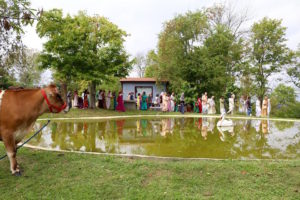
Varsana Maharaj escorts devotees on a parikrama around Radha Kunda during Radhastami 2016, following in the footsteps of the Six Goswamis.
More recently, he has “excavated” Radha Kunda and Lalita Kunda at Govardhana Hill in New Vrindaban, and is gradually constructing Radha-Gopinath Mandir, the first of Srila Prabhupada’s proposed replicas of the seven main temples of Vrindavan, India. This has become a much favored pilgrimage spot for the parikramas ISKCON New Vrindaban devotees regularly organize for guests.
Speaking about Varsana Swami, several longtime community members, including Pippalada, Gaura Shakti, Advaita, and others acknowledged that he and Amburish were two of the two hardest working members of New Vrindaban’s pioneer generation, out doing service right after mangala arati and not quitting until long after sundown.
They also appreciated his wonderful speaking abilities, recalling how in the early days, when he was known as Kashyapa Das, they were not yet evident. But as Varsana Swami studied Vaishnava scriptures intently over the years, and was cajoled into speaking by his peers, he grew to be the wise and eloquent teacher so many look to for inspiration today. He also authored two books, Gaura Lila and Path to Vraja.
After presenting Varsana Swami’s plaque to his disciple and ECO-V board member Sri Tulsi Manjari to give him later, the event concluded with a unique treat. In honor of Amburish and Pitambar, sweet rice was served out made by New Vrindaban’s pioneer dynamic cooking duo Advaita Das and Sudhanu Das, using Amburish’s classic recipe.
Having been shown by Amburish how he cooked sweet rice, they carefully recreated his methods by preparing it outside in a large pot over a fire pit, constantly stirring and aerating the sweet rice just as he did. They then kept the dessert in a freezer and fridge so it was served ice cold and with a distinct smokey flavor – two essential parts of the magic formula. The third, of course, was the love and devotion with which it was prepared.
“It was phenomenal,” says Chaitanya Mangala. “As Pitambar described Amburish’s sweet rice, it was truly heavenly.”
Ceremony participants savored the sweet rice along with a yellow cake with berry filling and whipped cream frosting, baked by Lakshman Ishvara Das and inscribed with the names of all the honorees. As they shared prasadam together, they kept the appreciative mood going in personal conversations.
“These events are definitely having an impact in the community, and I hope the mood of our appreciations will be expanded so they happen more often and in different ways,” says organizer and MC Chaitanya Mangala.
Others agree. “How can we go wrong when we glorify the devotees of the Lord?” asked Damodar Das. Meanwhile temple president Jaya Krsna Das commented that the appreciation ceremonies have become some of the most powerful community building activities he’s experienced during his time at New Vrindaban.
“It’s so important we let these devotees know their efforts are valued and appreciated, in order to help them maintain their enthusiasm and understand that their efforts are making a difference,” adds Chaitanya Mangala. “My hope is that we keep holding these ceremonies for as long as we have devotees to appreciate!”
Srila Prabhupada in New Vrindaban – 1969

Entrance to the original New Vrindaban farm, along the start of the famed Aghasura Road, circa 1970.
Excerpted from an article written by Cintamani Dasi and previously published in the Brijabasi Spirit, October 1985.
It was May 9th, 1969. Before coming to New Vrindaban, Srila Prabhupada visited the Columbus, Ohio center. By some inconceivable good fortune I met him and was initiated. After breaking open the storehouse of love of God in Columbus, Krishna sent Srila Prabhupada to New Vrindaban to bless the ground with his lotus feet.
From Columbus two carloads of devotes went to New Vrindaban. Kirtanananda Swami and Srila Prabhupada drove in a black Lincoln. I was eager to ride in the other car that was going, but Jaya Gopal, the temple president told me, “You can’t go. Srila Prabhupada doesn’t want any bramacarinis in New Vrindaban. Only brahmacharis and married couples.” I was devastated. An Indian lady who was visiting the center asked what was wrong, and I told her. She ran upstairs and told Srila Prabhupada.
“She can come,” he said. “Tell her she can stay as long as I am there.” Srila Prabhupada was so merciful! I got back in the car. Soon, Srila Prabhupada was sitting in the front seat of the other car, and they were off. We tried to keep up with them, but it was not easy.
After a couple of hours, we were driving on the winding roads of West Virginia. Then we went down a bumpy little road and parked next to the old school house.
We (Labangalatika, Nara Narayana, Hrisikesa and I) started walking up a narrow grass path that we could barely see. I was carrying a sleeping bag and a small suitcase, and after the first mile I was wondering if I was going to make it. “Oh God! Oh Krishna! When are we ever going to get there?”

Srila Prabhupada speaking with his followers outside the original New Vrindaban farmhouse, Spring 1969.
Finally, the small house came into view. As we got nearer, I saw Srila Prabhupada. He was sitting outside on the grass with several devotees around him. He was beaming. It was a beautiful, sunny, transcendental spring day. Seeing Srila Prabhupada made everything perfect. He was just sitting there, looking around at the devotees. It was obvious he really liked it in New Vrindaban.
Satyabhama brought prasadam out for the devotees, and along with Srila Prabhupada we honored the tasty prasadam. Satyabhama then served out more prasadam, but I was skipped. I was thinking, “I want more prasadam, but I don’t want to ask in front of my spiritual master.” Just then Srila Prabhupada looked at me and asked, “You want more?” Amazed, I said, “Yes.” I knew I had to be careful what I thought because Srila Prabhupada knew everything.
Later on, I looked over the “facilities.” The women – Syama Dasi, Labangalatika, and I – stayed on the second floor of the barn, above Kaliya, the cow. There was a well outside for water. In the afternoon we would literally slide down a steep hillside to Kesi Ghat to bathe. It was a little austere, but just being with Srila Prabhupada made everything ecstatic.
It was cold the first night we stayed in the barn. Morning came, and someone hit a gong – time to get up! Near the temple there was a small room where everyone put on tilak before entering the temple. Mangala arotika was so ecstatic! Srila Prabhupada would come downstairs and sit on a raised platform that had a gold pillow on it. Kirtanananda Swami would play harmonium. Sometimes Hayagriva would blow his kelp horn that was so long he practically had to stand in the kitchen to play. Everyone danced ecstatically. Afterwards, Srila Prabhupada would give classes on Srimad Bhagavatam.
After the morning program, the devotees would go to work. I washed pots and dishes. Outside the kitchen there was a wooden platform with a big tin tub on it, and I used to haul up well water and wash pots in the tub. We didn’t have scouring powder or soap. We used sand or pebbles to scrub the pots. They had to be very clean or Srila Prabhupada would complain. The best part about the service was that a few times a day Srila Prabhupada would come outside and walk right by, so even washing pots was ecstatic.
Once, when Srila Prabhupada walked by, a brahmachari was standing in front of the wooden platform playing his guitar, trying to teach me “Govinda Jaya Jaya.” He said he wanted to make a record, but since I was a new devotee, I didn’t know too much. Srila Prabhupada came over and said to him, “Why are you standing so near?” All of a sudden I could feel my face turning red. I realized that Srila Prabhupada didn’t want the women to be talking to the brahmacharis, even if it was just to learn a song. I was thinking, “I wish he would move.” But the brahmachari just stood there and said, “Oh, Srila Prabhupada, I was just teaching her this song.” “Oh,” said Srila Prabhupada, “You are teaching her?” And he just walked away.
After Srila Prabhupada took his lunch he always left some remnants. Often, the brahmacharis would run with his remnants into the woods, tackling each other to get the most. One day a new couple arrived. When the girl saw the brahmacharis running into the woods, she couldn’t understand the meaning of it. I explained that the remnants form the spiritual master’s plate are very potent.
On several occasions devotees came down from New York to visit Srila Prabhupada. The brothers Brahmananda and Gargamuni came one day, wearing jeans and suspenders. They came without notice, which produced some anxiety. “Would there be enough prasadam for Brahmananda?” He really could eat a lot of prasadam.

Srila Prabhupada & devotees enjoying prasadam near the original New Vrindaban cow barn, Spring 1969.
Although there were only a few devotees, we would still have a Sunday feast. During the feast the pots of prasadam were lined up outside. Every devotee would eat to their full satisfaction. Finished, some of the men would fall asleep on the grass near the pots, wake up later and eat more.
Srila Prabhupada’s lifestyle was so simple in New Vrindaban. Every morning his servant Devananda would heat up water in an aluminum pail over an outside fire. Srila Prabhupada would take the water and bathe in it in a little shack next to the temple. Sometimes in the morning, Srila Prabhupada would get a massage. One day Bhurijana dasa came and was taking some pictures of Srila Prabhupada getting a massage. Srila Prabhupada laughed and said, “These pictures are not for the Back to Godhead magazine!”
In the cool mornings, Srila Prabhupada would often take walks and a servant would follow, fanning him with a big leaf. I used to clean Srila Prabhupada’s room above the temple. In one closed off section he had small Radha Krishna Deities, and in the main section there was a mattress. Next to the mattress were two black trunks with some of Srila Prabhupada’s belongings and books. He used the trunks as a desk.
Early one morning, he came upstairs, surprising me. I was still cleaning his room. On the desk was a garlanded picture of Srila Bhaktisiddhanta. Srila Prabhupada took the garland off the picture and handed it to me saying, “This is from Krishna, with blessings.”
Then the day came for Srila Prabhupada to leave New Vrindaban. Srila Prabhupada walked at a brisk pace down the two mile path with all the New Vrindaban devotees behind him. I felt sad when he left but knew we couldn’t keep him there forever, although I would have liked that. We understood he had to spread Lord Caitanya’s mercy to other fallen souls.
Prabhupada’s Palace Launches Campaign to Support Restoration
By Madhava Smullen for ISKCON New Vrindaban Communications
Devotees at ISKCON New Vrindaban, West Virginia are in the midst of major renovations on Srila Prabhupada’s Palace. And they’re launching a campaign to help them continue restoring the renowned Smriti Samadhi, or memorial shrine to ISKCON’s Founder-Acharya, to its full glory.
The effort is a labor of love, just as it was when devotees first started building the Palace in 1973, intending it as a residence for their guru, who expressed a strong desire to retire there and translate his books.
“Regarding New Vrindaban I was very happy when I was there,” he wrote to them in 1974. “I am expecting very soon to go there and live in my proposed palace at least for some time.”
When Prabhupada passed away in 1977, the Palace – which opened to the public in 1979 – became a monument to his astounding achievements and gifts he gave to the world; a place where he resides in spirit through his instructions; and a major attraction for pilgrims and tourists.
But over the last thirty years, the Palace, which was built by enthusiastic yet inexperienced & young devotees, began to decay. Large parts of the decorative domes, outer wall, railings, and steps crumbled away, and sections of wrought iron rusted irreparably.
More recently, a Palace Restoration Committee was established to take action, and had specialized engineers give their assessment. Fortunately, the core of the building was safe and sturdy, but work had to be done on the exterior quickly.
This time, the work is being carried out with the assistance of professionals – both devotees and reputable local companies.
“The new concrete we are pouring has all the attributes that experience and modern technology provide,” says restoration manager Gopisa Das. “So it will significantly outlast what was used previously.”
The first move was installing a new, far more efficient drainage system on the steps leading up to the Palace.
“Water is the biggest contributing factor to deterioration,” Gopisa explains.
Next, the steps themselves were beautifully renovated by recycling the original rose-colored granite and adding new black granite treads with polished front edges. The work is currently about to be completed.
“Those distinctive pink and black colors now look the same as they did thirty-five years ago,” says Gopisa. “And the steps are sturdier and more durable than ever, with two-inch-thick treads rather than just the one inch that was there previously.”
Work on the outer wall – the first impression visitors get of the Palace – came next, and the hope is to complete its restoration this year as an offering to Srila Prabhupada for the 50th anniversary of his ISKCON.
The block wall was stripped, grouted and stabilized with rebar and concrete. As water had been leaking through the top, an attractive new waterproof, saffron-colored topping with lotus designs was installed. And the crumbling window frames were pulled out and replaced with new ornate black frames with Jaipur-style arches.
Next, beautifully ornate iron window grills will be installed, and the wall’s surface will receive a durable concrete stucco finish.
This will complete the first phase of restoration and exhaust ISKCON New Vrindaban’s current funding for the project. The second phase is repair of the Palace roof, which has been leaking and causing internal damage for years. Gopisa considers this a vital undertaking, and assuming financial support is available, he hopes it will be completed by the end of 2017.
“The entire roof has to be stripped down and rebuilt, along with a new heating, ventilation and air-conditioning system, and the domes need to be properly sealed,” says Gopisa. “That phase will also include rebuilding the crumbled balustrade railing around the Palace roof as well.”
With all this work, Gopisa says, “We are using the very best materials we can afford, to make it as long-lasting as possible, so the next generations won’t be faced with the same challenges we’re facing now.”
To the devotees in New Vrindaban there’s no doubt Prabhupada’s Palace is a sacred gem that must be revitalized. After all, it’s the only monument in the Western hemisphere built specifically to glorify Srila Prabhupada. It was constructed by volunteers who lovingly devoted years of their lives to its development. And it was beloved by Srila Prabhupada, who called its builders his “jewels” and promised, “I am already living here and always will be.”
Indeed, many devotees have commented they still strongly feel his presence there. Even tourists, who have never heard of Srila Prabhupada, are moved and affected. And in recent years, as media coverage of the Palace has once again increased, so have its visitors, with tens of thousands of pilgrims annually appreciating this sacred memorial to our beloved Founder-Acharya.
So please help support the restoration of Prabhupada’s Palace.
To offer your skills in renovation, contact Gopisa Das at gopisa108@gmail.com.
And to support the project financially, please contact Gaurnatraj Das at gaurnatraj@newvrindaban.com or phone 304 312 2069.
For more information, please visit:
http://palaceofgold.com/
http://www.newvrindaban.com/
New Vrindaban Recipes: Ice Cream and Sweet Rice Straight From Krishna’s Cows
By Madhava Smullen
Few prasadam stories from New Vrindaban’s history are as legendary as those of the late Amburish Dasa’s sweet rice and Pitambar Dasi’s ice cream.
Straight from the cow barn and prepared by the cowherd couple with deep love and devotion, they were much-craved treats in the austere lives of New Vrindaban’s early devotees.
Neither Amburish nor Pitambar had any cooking or cow-care experience before becoming devotees. Amburish, a city boy from Denver, Colorado, stopped at New Vrindaban on a road trip in 1971 just after high school, and instantly knew he was home. He moved to New Vrindaban and was initiated by Srila Prabhupada that same year.
Pitambar met devotees chanting at a craft show while living as a hippy in California’s Santa Cruz mountains. When one of the devotees told her all about New Vrindaban, she was similarly drawn to the place – she stayed over night at her first visit on Radhastami 1976, and never left.
Soon after, she received the service of caring for the calves, and met her husband-to-be Amburish in the barn, where he was in charge of the cows.
Amburish made an instant impression. An excellent kirtan leader and pujari, he was well known for his dedication, hard work and enthusiasm. “He could often be seen running from one service to another,” recalls his long-time friend Advaita Das. “He did not walk, he ran.”
But most of all, Amburish loved serving the cows.
“They were his heart and soul,” Pitambar says. “They weren’t just cows, they were like mirrors of his family. There were hundreds of them, and he named them all, and remembered their names. He involved our children, too – when our first son was born, he sat him on a cow when he was just two hours old. And our three sons – Nitai, Acarya and Anandamaya – were always playing in the barn while we were milking.”
Throughout the 1970s and early 1980s, Amburish kept meticulous records of all the cows’ activities, births, deaths, names, locations, and milk production amounts. He worked in the barn from early morning till late at night. He attended veterinarian school, so that he could deliver and breed the cows, and take care of all their medical needs.
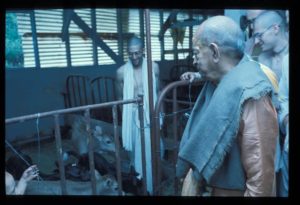
Amburish introducing Srila Prabhupada to four new-born calves at the Bahulaban Barn in New Vrindaban, June 1976.
And he saw Krishna in all of it. “He would tell us, ‘When you clean the barn, clean it so nicely that Krishna will want to bring Radharani here to take a walk through it,’” Pitambar says. “He would blast out the Govindam prayers to call the cows in from the pasture. And he always chanted while milking them.”
The fresh, whole milk from cows protected with such love and devotion was an essential part of Amburish’s legendary sweet rice.
But so, too, was the way he applied that same care and devotion to preparing the dish.
“First he would go take a shower, and get dressed in his dhoti and brahmana thread, as if he was getting ready for pujari work,” says Pitambar.
Then Amburish would carefully measure out all the ingredients, which at different times included spices like bay leaves, camphor, and cardamom but eventually were reduced to a pure blend of just four items: fresh milk, rice, sugar and raisins.
Cooking outside over a wood fire in a huge 30 gallon pot, he would alternately scrape the bottom of the pot to keep the sweet rice from burning, and aerate the milk with a one gallon ladle. Consistency was king, and Amburish wanted it to be perfect. Meanwhile, he chanted bhajans the entire time without cessation.
“It was just so magical to watch,” says Pitambar.
Depending on the time of year, Amburish would then cool the sweet rice in a stream, a root cellar, or a snowbank. The resulting dish was a Sunday or festival treat that inspired feverish devotion in a New Vrindaban community that lived on an austere diet during the week. One tradition on Balarama Rasayatra saw Amburish hiding the sweet rice out in the pasture for Lord Balarama and his Gopis, which the devotees would hunt desperately for at night, to no avail.
“I had experienced sweet rice before, but Amburish’s sweet rice took the experience to a new level,” says Advaita. “To this day I have never tasted sweet rice anywhere – at any other temple or restaurant – that even comes close.”
Another much sought-after treat was Pitambar’s ice cream, rich in flavor as it was also made with the excess milk from Krishna’s cows. “I would blend milk, sugar and fruit in an ice cream machine, put it in a five-gallon bucket, take it to the prasadam room, and sell it for 35 cents a cup,” she says. “Back then, it was so austere, that anything sweet was like, ‘Oh, boy!’ What’s more, it was something different – not on the Vedic menu. The cups just flew out!”
For New Vrindaban’s three biggest festivals at the time – Memorial Day, Fourth of July, and Labor Day, which all ran over three-day weekends and drew thousands of devotees, pilgrims and tourists – Pitambar would make an incredible 100 gallons of ice cream a day.
“I would stay up for three days straight, not sleeping at all, to make it,” she says. “I’d have to make it only four gallons at a time, because that’s all the milk the machine would hold. And I made a different flavor of ice cream each day: carob, using a Hershey-like syrup; strawberry; and orange-mango, using real fruits rather than concentrate.”
Pitambar also worked extremely hard the rest of the year, too. In the early days, she made chapatis and washed pots, scrubbing them with ashes from the cooking fires because there was no soap.
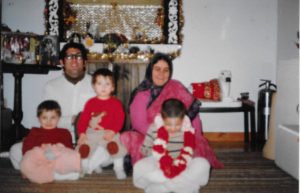
From left to right: Acarya, Amburish, Ananda, Pitambar & Nitai, circa 1986. Photo taken in the living room of what is currently Nityodita & Radha’s house in New Vrindaban.
Later, she took care of the calves as diligently as Amburish did the cows. “I just loved them,” she says. “They were like my children. They were so much fun, and so sweet. I would feed them bottles of milk, and I’d look down, and my entire sari would be in their mouth!”
Pitambar also cleaned the calves’ pens, brushed them, and fed them grain and hay as they got older, walking from one farm to another to care for calves of different age groups.
They were inseperable. At one point early on before she was married, Pitambar attempted to leave New Vrindaban and move to the temple in Berkely, California. “Then I dreamt about the calves,” she recalls. “They were crying, asking me to come back. I started packing my bags right away. The Berkely leaders begged me to stay, offering me trips to India, saris, a new apartment. I said, ‘No, I have to go back to my calves!”
Pitambar also made ghee and milk sweets from New Vrindaban cow milk for the Deities and guests, and churned butter by hand. She had to churn it in a stream in the summer to keep it cool, and on the coals of the cooking fires in the winter to keep it from solidifying.
From 1976 to 1980, she and Amburish ran a full snack bar from the barn, with her ice cream, French fries cooked in ghee, Bhima burgers, and pizza with home-made cheese. During this period, she also worked at Prabhupada’s Palace until its opening in 1979, doing gold-leaf and touching up moldings.
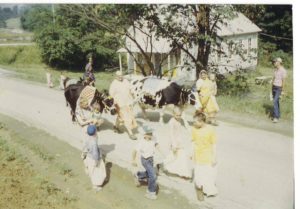
Pitambar leading Sita cow in the procession moving Sri Sri Radha Vrindaban Chandra from Bahulaban to Their current temple in New Vrindaban, July 4th Weekend 1983.
From 1983 to ’84, Amburish and Pitambar oversaw the teenage boys’ ashram, which Pitambar says was ‘like a big, happy family.’
Former students agree. “We lived at the Vrindaban farmhouse, which, at the time, was quite remote and removed from the rest of the community,” says alumni Chaitanya Mangala Das. “This meant the adolescent boys were able to engage in a lot more fun activities that weren’t really allowed before or after that period. For those in that ashram there is a general consensus this was our favorite time in gurukula, and Pitambar and Amburish were our favorite ashram teachers.”
Later, the couple worked at ISKCON’s restaurant in Pittsburgh, and supplied the Rainbow Kitchen for the homeless with food.
In 1989, Amburish passed away in New Vrindaban, and his ashes were scattered at the Kusum Sarovara Lake there.
In his absence, Pitambar started her own herbal goods cottage business to support herself and her boys. Taking her tinctures, homeopathic medicines, dried flower arrangements and herbal-infused creations to local craft fairs she worked hard and became well-known in the area, making the cover of the Wheeling Register.
In 2001, she finally left New Vrindaban to take care of her mother in Pittsburgh. Today, she still lives there while her son Nitai and other caregivers take care of her, as her advanced Parkinson’s leaves her disabled and homebound.
“Pitambar is a kindhearted, gentle and humble devotee, whose caregivers say she has ‘taught them a lot about life,’” says Pitambar’s closest friend Tilakini Dasi, who calls every day to keep her spirits up.
“She’s a generous and empathetic soul who cares a lot about others, and a fiercely dedicated mother,” adds Rupa Dasi, another lifelong friend.
Sure enough, Pitambar herself hopes she’ll be remembered for always trying to be kind to everyone, and says that being a mother was her favorite and most important service.
She is very proud of her grown-up sons Nitai, who works at an irrigation company as well as caring for her; Acarya, who serves in the U.S. Navy; and Ananda, a former combat medic, who recently got engaged and is now attending ultrasound tech school.
“They might have very different lives now than they did growing up,” Pitambar says. “But Ananda says his happy place will always be laying on a blanket in Radha Vrindaban Chandra’s temple room during mangala arati.”
New Vrindaban is Pitambar’s happy place, too. “It’s where I spent most of my adult life,” she says. “There was good and bad there, but it was home. I miss it terribly. I wish I could physically go there more, but my health won’t currently allow it.”
Pitambar has potent advice for the next wave of New Vrindaban residents. “Our lives are precious and go by fast. We don’t always know Krishna’s plan, so we should use our time wisely.”
She concludes, “New Vrindaban is a very special place. It is the home of Srila Prabhupada, Sri Sri Radha Vrindaban Chandra, and so many wonderful Brijabasis. So please, let’s do our best to love and respect each other in the Holy Dhama.”
Amburish’s Heavenly Sweet Rice
(Makes about 12 cups)
“Of the many wonderful dairy-based recipes from the pioneer days of New Vrindaban, Amburish’s sweet rice remains my all-time favorite,” Pitambar says. “Of course, the most important ingredient was his enthusiastic devotion, every time he made it. Made with the same care, this heavenly sweet rice is a wonderful way to honor Lord Krishna, His cows and cowherds.”
Ingredients:
1 gallon fresh milk (whole milk, from protected cows, if possible)
1 cup long grain rice (creates a better consistency and flavor than basmati)
3 cups white sugar (cut down if too sweet)
Small palm full of raisins
Directions:
Combine milk and rice in a thick-bottomed pot. Cook on a medium heat, making sure to scrape the bottom of the pot constantly so that the milk will not stick and burn. When the milk begins to boil, begin ladling the milk as well as stirring it – this serves to aerate the milk and keep it from boiling over.
After half an hour, add raisins. When the mixture has been cooking for about 45 minutes, begin watching it closely. Consistency is key – it should be neither too thin nor too thick. Pick up some of the sweet rice in the ladle, swish it around, and check that the rice is floating on top of the milk and that the milk itself leaves a thin coating on the ladle.
When it reaches this point, remove the sweet rice from the fire and stir the sugar in thoroughly.
Chill the sweet rice, offer to the Lord and serve ice cold.
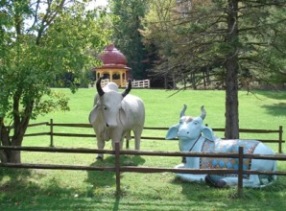
Welcome to Brijabasi Spirit
Thank you for taking the time to visit the New Vrindaban community blog. Think of visiting our blog as making a virtual pilgrimage.
Hare Krishna Hare KrishnaKrishna Krishna Hare Hare
Hare Rama Hare Rama
Rama Rama Hare Hare
"May cows stay in front of me; may cows stay behind me; may cows stay on both sides of me. May I always reside in the midst of cows."
Hari Bhakti-vilas 16.252










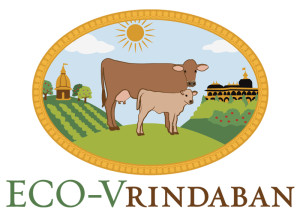
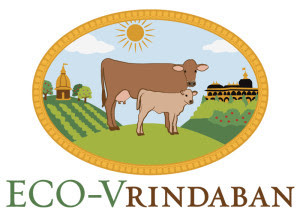
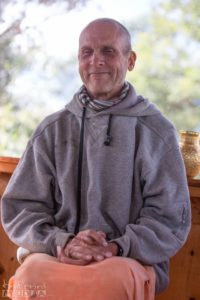
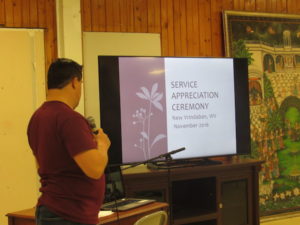
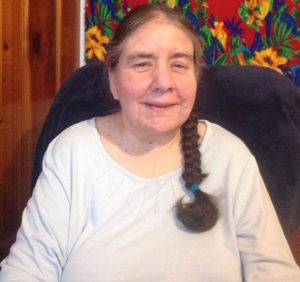
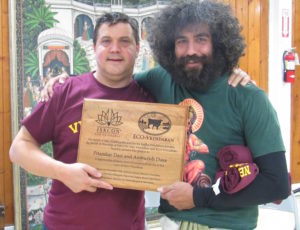
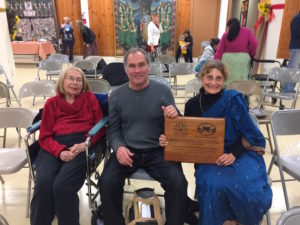
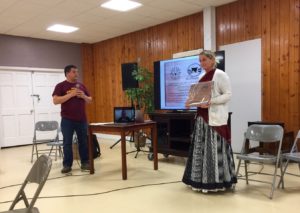
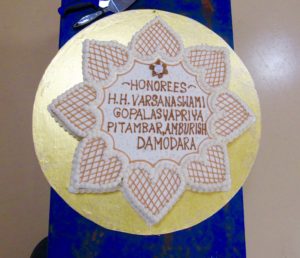
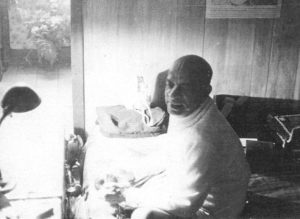
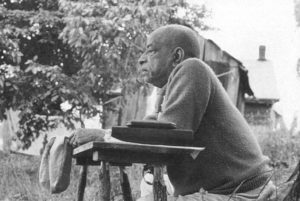
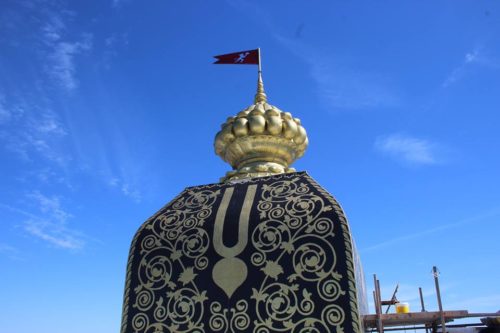
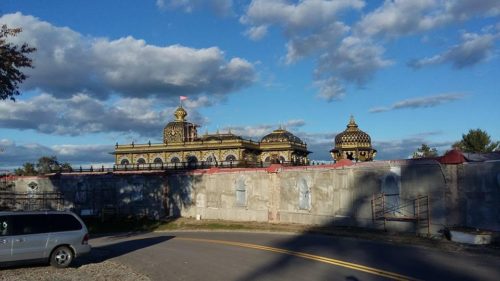
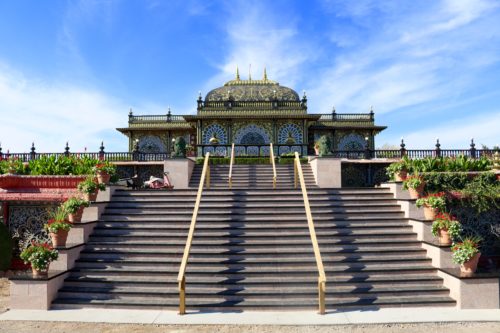
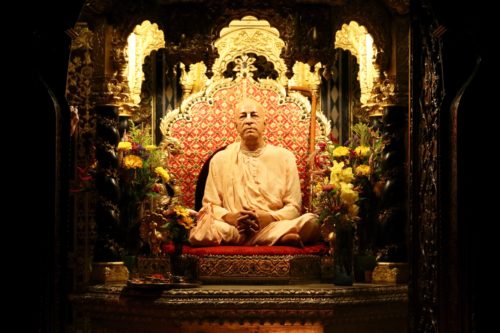
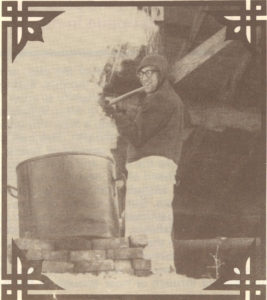
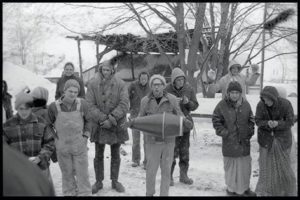
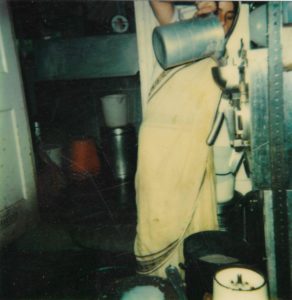





Recent Comments